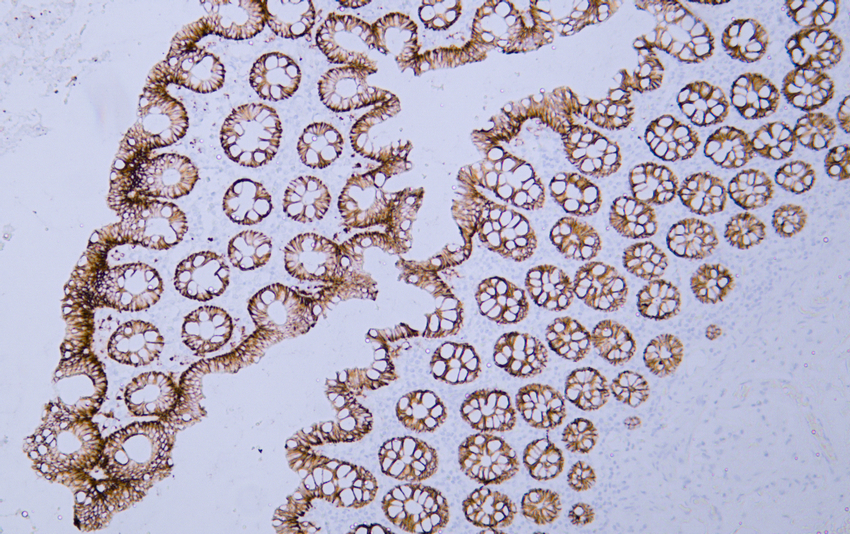Claudin 7 (ABT443) IHC kit
- Catalog No.:IHCM6188
- Applications:IHC
- Reactivity:Human;
- Target:
- Claudin 7
- Fields:
- >>Cell adhesion molecules;>>Tight junction;>>Leukocyte transendothelial migration;>>Pathogenic Escherichia coli infection;>>Hepatitis C
- Gene Name:
- CLDN7 CEPTRL2 CPETRL2
- Protein Name:
- CEPTR L2;CEPTRL 2;CEPTRL2;Claudin 1;Claudin 7;Claudin 9;Claudin-7;Claudin1;Claudin7;Claudin9;CLD7_HUMAN;CLDN 7;CLDN-7;CLDN7;Clostridium perfringens enterotoxin receptor like 2;CPETR L2;CPETRL 2;CPETRL
- Human Swiss Prot No:
- O95471
- Mouse Swiss Prot No:
- Q9Z261
- Rat Swiss Prot No:
- Q9Z1L1
- Immunogen:
- Synthesized peptide derived from human Claudin 7 AA range: 100-211
- Specificity:
- The antibody can specifically recognize human Claudin 7 protein.
- Source:
- Mouse, Monoclonal/IgG2b, kappa
- Purification:
- The antibody was affinity-purified from ascites by affinity-chromatography using specific immunogen.
- Storage Stability:
- 2°C to 8°C/1 year
- Other Name:
- CEPTR L2;CEPTRL 2;CEPTRL2;Claudin 1;Claudin 7;Claudin 9;Claudin-7;Claudin1;Claudin7;Claudin9;CLD7_HUMAN;CLDN 7;CLDN-7;CLDN7;Clostridium perfringens enterotoxin receptor like 2;CPETR L2;CPETRL 2;CPETRL2;Hs.84359
- Background:
- This gene encodes a member of the claudin family. Claudins are integral membrane proteins and components of tight junction strands. Tight junction strands serve as a physical barrier to prevent solutes and water from passing freely through the paracellular space between epithelial or endothelial cell sheets, and also play critical roles in maintaining cell polarity and signal transductions. Differential expression of this gene has been observed in different types of malignancies, including breast cancer, ovarian cancer, hepatocellular carcinomas, urinary tumors, prostate cancer, lung cancer, head and neck cancers, thyroid carcinomas, etc.. Alternatively spliced transcript variants encoding different isoforms have been found.[provided by RefSeq, May 2010],
- Function:
- function:Plays a major role in tight junction-specific obliteration of the intercellular space.,induction:By androgens.,similarity:Belongs to the claudin family.,subunit:Directly interacts with TJP1/ZO-1, TJP2/ZO-2 and TJP3/ZO-3.,tissue specificity:Expressed in kidney, lung and prostate. Isoform 1 seems to be predominant, except in some normal prostate samples, where isoform 2 is the major form. Down-regulated in breast cancers, including ductal carcinoma in situ (DCIS), lobular carcinoma in situ (LCIS) and invasive ductal carcinoma (IDC) (at protein level), as well as in several cancer cell lines. Loss of expression correlates with histological grade, occurring predominantly in high-grade lesions.,
- Subcellular Location:
- Membranous
- Expression:
- kindey
- June 19-2018
- WESTERN IMMUNOBLOTTING PROTOCOL
- June 19-2018
- IMMUNOHISTOCHEMISTRY-PARAFFIN PROTOCOL
- June 19-2018
- IMMUNOFLUORESCENCE PROTOCOL
- September 08-2020
- FLOW-CYTOMEYRT-PROTOCOL
- May 20-2022
- Cell-Based ELISA│解您多样本WB检测之困扰
- July 13-2018
- CELL-BASED-ELISA-PROTOCOL-FOR-ACETYL-PROTEIN
- July 13-2018
- CELL-BASED-ELISA-PROTOCOL-FOR-PHOSPHO-PROTEIN
- July 13-2018
- Antibody-FAQs
- Products Images

- Human appendix tissue was stained with Anti-Claudin 7 (ABT443) Antibody

- Human colon tissue was stained with Anti-Claudin 7 (ABT443) Antibody

- Human salivary gland tissue was stained with Anti-Claudin 7 (ABT443) Antibody

- Human appendix tissue was stained with Anti-Claudin 7 (ABT443) Antibody

- Human colon tissue was stained with Anti-Claudin 7 (ABT443) Antibody

- Human salivary gland tissue was stained with Anti-Claudin 7 (ABT443) Antibody



